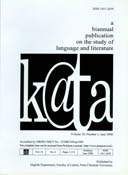Modern Rape-Revenge Movies and Shelley’s The Cenci
Abstract
Viewing Shelley’s The Cenci from the political upheavals of the nineteenth century would limit one’s response to the play to the issues of that century. However, this play continues to be played in the twenty first century, which makes one wonder how a modern spectator with a feminist inclination might react to the theme of rape and revenge. The Cenci shares with a number of movies flourishing with the rise of the second wave feminism during the 1970s, the theme of a female victim transformed into a hero-avenger, who takes law into her own hands and avenges herself in the face of a dysfunctional legal state. As revisions of the archetypal narratives of violation-revenge-violation, these modern movies have been praised for depicting heroines who are no longer powerless, miserable and victimized, but strong enough to avenge themselves with impunity. Though The Cenci repeats the traditional pattern of violation-revenge-violation, it focuses on the corruption and irresponsibility of the patriarchal legal system as well as its reformation, which have been neglected by both mythical narratives and modern rape-revenge movies. By reading The Cenci along with William Blake’s “Visions of the Daughters of Albion” and Shelley’s “Prometheus Unbound,” we examine how The Cenci challenges the modern rape-revenge movies and how Beatrice could have used her agency and her anger in a more effective way to fight against tyranny.
Downloads
References
Bates, E. S. (1908). A Study of Shelley’s Drama The Cenci. The Columbia UP.
Blake, W. (1993). Visions of the Daughters of Albion. In M. H. Abrams (Ed.), The Norton Anthology of English Literature, 6th ed. Vol. II. New York: W. W. Norton.
Bloom, H. (1970). Blake’s Apocalypse: A Study in Poetic Argument. Cornell University Press.
Bowers, K. P. (2008). “Misreading Justice: The Rhetoric of Revenge in Feminist Texts about Domestic Violence.” (PhD diss., University of Texas, 2008.
Canuel, M. (2004). Religion, Toleration, and British Writing 1790-1830. Cambridge & New York: Cambridge University Press.
Clover, C. J. (1992). Men, Women, and Chain Saws: Gender in Modern Horror Film. New Jersey: Princeton University Press.
Cox, J. N. (1987). In the Shadows of Romance: Romantic Tragic Drama in Germany, England, and France. Athens: University of Ohio Press.
Damon, S. F. (1988). A Blake Dictionary: The Ideas and Symbols of William Blake. Hanover and London: Trustees of Brown University.
Davy, D. (1990). The Harmony of the Horrorscape: A Perspective on The Cenci. Journal of Dramatic Theory and Criticism, 5 (1), 95-113.
Dempsey, S. (2012). The Cenci: Tragedy in a Secular Age. ELH, 79 (4), 879-903.
Ferriss, S. (1998). Percy Bysshe Shelley’s The Cenci and the Rhetoric of Tyranny. In T. A. Hoagwood & D. P. Watkins (Eds.), British Romantic Drama: Historical and Critical Essays (pp. 208-28). London & New Jersey: Associated University Press.
Griffin, S. (1982). Made from this Earth: Selections from her Writing, 1967–1982. London: Women’s Press.
Heller-Nicholas, A. (2011). Rape-Revenge Films: A Critical Study. North Carolina: McFarland & Company, Inc., Publishers.
Mulhallen, J. (2010). The Theater of Shelley. Cambridge: Open Book Publishers CIC Ltd.
Pistono, S. P. (1988). Susan Brown Miller and the History of Rape. Women’s Studies, 14 (3), 265-76.
Ponser, R. A. (2009). Law and Literature. 3rd ed. London: Harvard University Press.
Projansky, S. (2001). Watching Rape: Film and Television in Postfeminist Culture. New York & London: New York University Press.
Read, J. (2000). The New Avengers: Feminism, Femininity and the Rape-Revenge Cycle. Manchester & New York: Manchester University Press.
Saunders, C. (2001). Rape and Ravishment in the literature of medieval England. Cambridge: D. S. Brewer.
Shakespeare, W. (1821). The Rape of the Lucrece. In J. Boswell (Ed.), The Plays and Poems of William Shakespeare Vol. XX. London: C. Baldwin Printer.
Shakespeare, W. (1752). Titus Andronicus. In The Works of Shakespeare. Vol. VI. London, J. and P. Knapton, 1752.
Shelley, P. B. (1886). The Cenci. London: Reeves & Turner.
Shelley, P. B. (2002a). A Philosophical View of Reform. Woodcock.
Shelley, P. B. (2002b). Prometheus Unbound. Woodcock.
Shelley, P. B. (2002c). The Revolt of Islam. Woodcock.
Sperry, S. M. (1988). Shelley’s Major Verse: The Narrative and Dramatic Poetry. Cambridge: Harvard University Press.
Stauffer, A. M. (2005). Anger, Revolution and Romanticism. New York: Cambridge University Press.
Strand, G. & Zimmerman, S. (1996). Finding an Audience: Beatrice Cenci, Percy Shelley and the Stage. European Romantic Review, 6 (2), 246-268.
Tomoko, M. (2011). British Romanticism and the Catholic Question: Religion, History and national Identity, 1778-1829. New York: Palgrave Macmillan.
Wassermann, E. (1971). Shelley: A Critical Reading. Baltimore: The Johns Hopkins UP.
Wilson, J. D. (1978). Beatrice Cenci and Shelley's Vision of Moral Responsibility. Ariel 9 (3), 75-89.
Woodcock, B. (Ed.). (2002). Selected Poetry and Prose of Shelley. Hertfordshire: Wordsworth Editions Limited.

This work is licensed under a Creative Commons Attribution 4.0 International License.
This work is licensed under a Creative Commons Attribution License





















